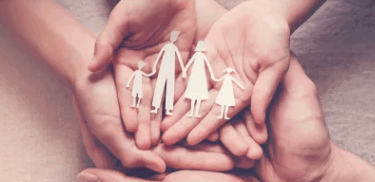The option you’ve never heard about is less expensive, has a shorter waiting list and allows adoptive moms to experience pregnancy.
John and Anika Dejong of Ontario, Canada were unable to conceive naturally and happily adopted their first two children in 1999 and 2000.
But the couple longed for another child and Anika wanted to experience pregnancy. In 2003, two embryos adopted from a family in Arizona, who created them during in vitro fertilization procedures, were transferred into Anika’s womb, and their third child, a healthy son, was born nine months later.
Cara and Gregg Vest tried to get pregnant for six years. After three IVF (In Vitro Fertilization) attempts, they faced the prospect of paying upwards of $30,000 for an overseas adoption or a lengthy wait for a domestic adoption. But adopting an embryo, frozen after another couple’s successful IVF cycle, would be a fraction of the cost and time. They now have one son and a daughter on the way.
My husband and I were twice blessed with beautiful, healthy girls through the miracle of IVF. Having witnessed the wonder of microscopic 6-celled embryos transforming into the giggling, pink cheeked children we love, we couldn’t justify the destruction of the frozen embryos left over from our last in vitro cycle. After the amount of tears, prayer and hope that went into creating those tiny lives, we could never throw them away.
A year and a half after the birth of our youngest daughter, we donated the remaining embryos for adoption. They were adopted three months later by a couple in California who matched our requirements regarding marital status, education level, health, age, and religion. Although the decision was a monumental one for us, we felt it was the morally correct one. We hope that our choice offered those unborn babies a chance at life while giving another family the chance to experience the immeasurable joy of parenthood.
Frozen Hope
When couples such as my husband and I use in vitro fertilization to become pregnant, there are often excess embryos – consisting of as few as four cells – that are frozen and stored for potential future use. Some families use all of their frozen embryos in subsequent attempts to become pregnant, while others donate those embryos to stem cell research.
Another option is to allow them to thaw and die. But there’s an exciting new choice – embryo adoption. It’s estimated that there are approximately 400,000 embryos in cryopreservation (deep freeze) in fertility clinics throughout the country, and thanks to the efforts of organizations like the Snowflakes Frozen Embryo Adoption Program and the National Embryo Donation Center (NEDC) located in Knoxville, TN, many of those embryos are now available for adoption.
Eligibility
Embryo adoption is a relatively new and exciting path to parenthood, so there is no national oversight governing the process. However fertility clinics like San Francisco’s Pacific Fertility Center (PFC), traditional adoption agencies that participate in embryo adoption like Snowflakes NEDC treat embryo adoption much like traditional newborn adoption and have implemented similar rules and safeguards: There are no religious restrictions, but age is certainly a factor, since a prospective mother must be able to safely carry a pregnancy to term.
Some programs require that women be less than 45, while others require an obstetrician’s letter confirming that a woman is a good candidate for pregnancy. The NEDC requires that couples have been married for 3 years and that adoptive parents complete the same home study required of live adoptions. The home study consists of a thorough medical screening, psychological testing and a review of a family’s finances. According to NEDC Public Relations Manager, Diahn Oakley, “This is the honor the wishes of our donor families who want to place their embryos in the most stable home environment.”
Joe Conaghan, Ph.D., Lab Director at PFC says that the clinic will allow adoption by single women and gay couples if the donors agree and that PFC has an “in house counselor that meets with parents and discusses the issues before moving forward.”
Cost
Compared to IVF or the adoption of a live child, embryo adoption is a financial drop in the bucket, costing between $2,000 if parents are matched at a local fertility clinic like PFC to $5,000 with a national program like the NEDC or Snowflakes that handles the home study (about $900), medical tests, surgical procedures, legal consents and shipping embryos from state to state.
To offset those costs, medical insurers that cover infertility treatments may pay for any necessary medications, hormone treatments or the cost of the embryo transfer (into the mother’s womb). Plus, federal tax credits of up to $10,950 will reimburse couples for the home study and possibly other related expenses.
Timing
The great news is that there is no waiting list for embryos. However, because there is paperwork to fill out, minor medical tests to perform and in most cases, a formal home study to complete, the process usually takes between 6 and 12 months for adoptive parents. The Dejongs, who went through the Snowflakes program, describe their experience: “In the fall of 2002 we were matched with a couple from New Mexico with 5 embryos.
We were able to email them to ask questions, and both families wrote biographies so we could get to know one another. We filled out our paperwork in December and the embryos were shipped to us in California in February of 2003. We transferred two embryos in March and our son was born in December.”
Things happen rapidly from the donor’s perspective because biological parents are only required to complete a few legal forms and undergo a couple of blood tests for infectious and genetic diseases – many of which were already performed when they created the embryos in the first place. Our embryos were adopted 3 months after we released them, but the adoptive couple had already finished their paperwork and were awaiting a match.
Process
Once a woman has been deemed fit for pregnancy, the parents are have completed their home study or counseling and a match has been made with donor parents, the embryos are often shipped from the state in which they are currently stored to a local fertility clinic where the adoptive parents reside. Then, with the aid of her doctor, a hopeful mother tracks her fertility cycle and the embryos are transferred into her uterus at the doctor’s office using a small catheter.
It’s a painless process that takes about 15 minutes. Some women take hormones for a few weeks prior to the embryo transfer and many take progesterone supplements for the first trimester to help ensure a robust uterine lining. That’s it!
Benefits
For many families, the low cost of embryo adoption is the greatest benefit. It gives hope to couples whose savings may have been depleted through expensive fertility treatments or who may have already spent large sums of money adopting a child domestically or internationally, but who want to continue to add to their family.
Having full knowledge of their child’s genetic and medical history is another reason parents make this unique choice. Anyone who creates embryos by in vitro fertilization must undergo rigorous medical testing to ensure the resulting babies are healthy, therefore anyone adopting them is guaranteed that the biological parents were in top physical condition, free from disease and drugs.
In addition to these safeguards, even if the biological parents decide to remain anonymous, they must create a comprehensive medical history for as many generations as they are able, so adoptive parents can see if illnesses like cancer or diabetes run in the family.
Anonymous donors also have the option of including pictures of themselves and of any children they may already have, and they can informative letters to hopeful parents. Many families choose open adoptions and get to know each other before making such a huge decision and some keep in touch years later via email and letters.
The Dejong’s preferred an open adoption because their two older children have contact with their birth families and they wanted to make sure their youngest son had knowledge of his biological family too.
But what truly makes embryo adoption so unique is that is allows infertile couples to experience pregnancy, childbirth and breastfeeding. Anika Dejong says, “Pregnancy was a lot of fun. I absolutely loved being pregnant and felt great the whole time.” Those nine months of morning sickness and tiny kicks help new parents bond with their babies and prepare for parenthood, as well as letting women join the ranks of their pregnant peers swapping labor and delivery stories for years to come!
Risks
Unlike newborn adoption, where the biological mother assumes the risks of pregnancy and childbirth, embryo adoption turns the tables and places the risk of miscarriage, still birth, birth defects and the possibility of a difficult delivery upon the adopting mother. Because most people decided to transfer two or more embryos at a time in order to increase their chances of conception, the chance of a multiple pregnancy (twins and triplets) and all the associated complications come with it.
Uncertainty is another risk. When a person chooses traditional adoption, in the vast majority of cases, they will eventually bring home a child. But embryo adoption is no guarantee. Only 2/3 of frozen embryos survive the thawing process. And of the ones that are viable for implantation into a mother, the chances of conception are still only around 30-35% per attempt.
Conaghan says, “About 1 in 3 women that has embryos to adopt will go home pregnant.” Because of those odds, Oakley adds, “Most families will need to do more than one transfer to achieve pregnancy. At the NEDC, adoptive parents make first, second and third choices of donated embryos in case the initial attempt doesn’t work.”
Presidential Support
President George W. Bush recently approved a $1 million federal grant to help publicize frozen embryo adoption. On May 24, 2005, the President held a press conference where he encouraged families to consider this life affirming option. Surrounded by 21 children born through the miracle of embryo adoption he said, “The children here today remind us that there is no such thing as a spare embryo.
Every embryo is unique and genetically complete, like every other human being. And each of us started out our life this way. These lives are not raw material to be exploited, but gifts. And I commend each of the families here today for accepting the gift of these children and offering them the gift of your love.”
Tiny Treasures
Embryo adoption is a great option for women who may experience infertility for a variety of reasons, but who, if given the chance, could safely gestate a baby. Factoring in the relatively short waiting period, the ability to experience pregnancy and the extraordinarily low cost, it’s easy to see why parents who have heard about embryo adoption are so excited about this new and exciting alternative.
For couples like my husband and me, it’s a compassionate alternative to destroying the lives we created. If you think embryo adoption might be a good choice for you, an e-mail or phone call to a participating organization listed here could be your one way ticket to the delivery room!
Deborah Bohn is the author of our complete adoption series, and a frequent contributor, mom and resident in Williamson County.
National Embryo Donation Center
10810 Parkside Drive – Suite 304
Knoxville, TN 37922
Toll Free: 866-585-8549
Telephone: 865-218-6600
Fax: 865-218-6666
E-mail: embryodonation.org
Snowflakes Frozen Embryo
Adoption Program
801 East Chapman Avenue
Suite 106
Fullerton, California 92831
714.278.1020
FAX: 714.278.1063
E-mail: InfertilityDoctor.com




